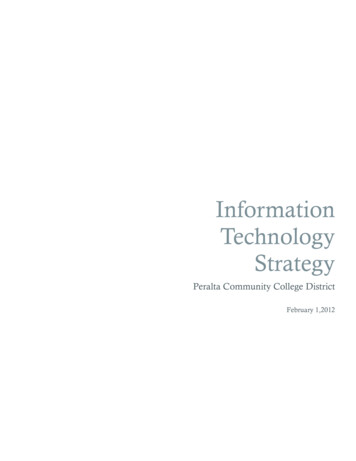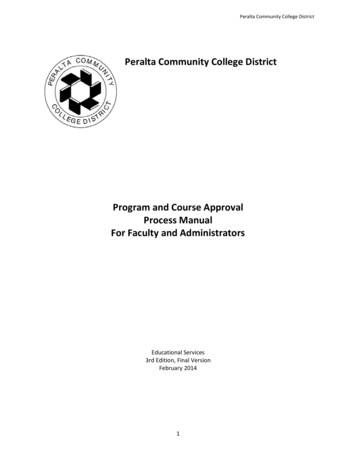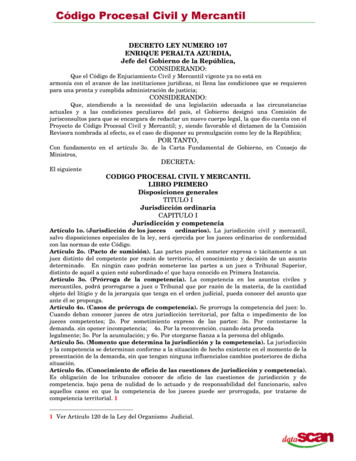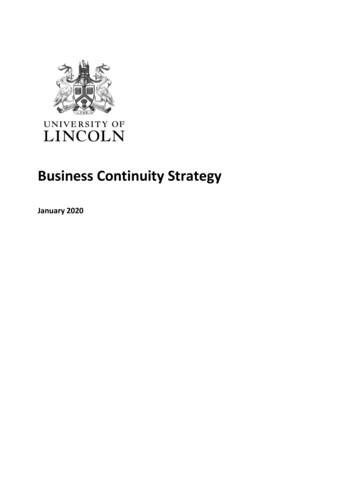
Transcription
InformationTechnologyStrategyPeralta Community College DistrictFebruary 1,2012
Information Technology Strategy, 2012-2015Peralta Community College District Mission StatementOur MissionWe are a collaborative community of colleges.Together, we provide educational leadership for the East Bay, delivering programs and services thatsustainably enhance the region’s human, economic, environmental, and social development.We empower our students to achieve their highest aspirations. We develop leaders who createopportunities and transform lives.Together with our partners, we provide our diverse students and communities with equitable access to theeducational resources, experiences, and life-long opportunities to meet and exceed their goals.Our GoalsStudentsA. Advance Student Access, Equity, and SuccessCommunitiesB. Engage Our Communities and PartnersProgramsC. Build Programs of DistinctionCollaborationD. Create a Culture of Innovation and CollaborationResourcesE. Develop Resources to Advance and Sustain our MissionPeralta Community College District2
Information Technology Strategy, 2012-2015IntroductionWhat an IT strategy isAn IT strategy is a process that organization goes through to identify and define a portfolio of projects thatwill help your organization achieve strategic goals.In order for the strategy to be successful, these projects must be staffed and budgeted. Otherwise, it's a nicereport that sits on the shelf while the organization continues to allocate its IT resources in an ad hoc andreactive manner. It is important, then, that the IT strategy feed into the districts formal budget process.ProcessWe assembled representatives from all the colleges and most of the functional areas. The team metmonthly starting in September and culminated its work in early January. Using the district's overallstrategic goals as a reference, identify problems and shortcomings with the districts existing IT capabilitythat would constrain the district from meeting its strategic goals. The workgroup felt that the shortcomingscould be organized into 5 themes:Institutional ability to deliver The overall lack of project management skills in the district has resulted in either projects failing orelse expensive consultants being hired to drive projects to completion. IT governance, the process by which decisions are made and standards are established, has beenweak at best. The district does not have well-defined and established IT processes. Instead, IT services aredemanded and delivered in an ad hoc, uncoordinated fashion, resulting in unhappy customers andoverworked, demoralized IT staff. There are big holes in the IT skill sets necessary to support PeopleSoft. The District PeopleSoftteam is understaffed, and does not have the range of skill sets necessary to support even day-to-daymaintenance of the system, much less implement new modules and functionality, resulting in aheavier reliance on consultants.Sustainable IT infrastructure Tech refresh (that is, the set of processes and policies that ensures that an organization renews itstechnology infrastructure and maintains an adequate level to support its business operation) is adhoc and unplanned. It is highly dependent on bond and other, one time funding sources. There is a highly uneven distribution of IT capability not only between the colleges and the districtoffice, but also within the colleges themselves.Peralta Community College District3
Information Technology Strategy, 2012-2015 There are no standards or economies of scale for procurement. Purchases of IT assets are done inan ad hoc and uncoordinated fashion, resulting in the district as a whole getting less value for itsdollar of IT investment. Given that the IT asset base for the district as a whole is between 10- 15million, there are significant opportunities for a more standardized and coordinated theprocurement process.Reduce back-office costs HR, finance, procurement, IT, and district governments are all necessary to the effective operationof the colleges. The question is how to get better service in these functions at lower cost, freeing upresources for delivery of services to students. Much of the cost of the back-office is in transaction processing. The district has a major asset thatcan help with reducing the overall cost of transaction processing: it owns a large number ofPeopleSoft modules, only a few of which it has implemented.Business intelligence The district is deluged with data from its transactional systems but has limited ability to make gooduse of it. Student data is an exception. Starting in 2008, the district built a student data warehouse that hasbecome a critical resource for enrollment management. Traditional reporting is about control and accountability (and there's lots of room for improvementin this area at the district), business intelligence is about gaining insight based on hard data and indeveloping strategies based on those insights. As part of the student data warehouse project, the district purchased a world-class businessintelligence tool: Oracles Business Intelligence Enterprise Edition, or OBIEE. In addition, thedistrict has, as part of its overall PeopleSoft license, prebuilt data warehouses for finance, HR, andprocurement.Mobile learning With the explosive growth of smartphones and tablets, the digital divide is dying a rapid death. While many of our students may not have access to broadband and their homes, wireless access forsmart phones is becoming nearly ubiquitous in public spaces such as coffee houses, libraries, andentire college campuses. 50% of the devices that are attached to the Internet are not traditional PCs or laptops, but theDistrict is still building systems and delivering content only to traditional PCs. Our students are increasingly abandoning traditional PCs and hardwire connections forsmartphones and tablets connected through Wi-Fi or 4G cell service. This is the YouTube, wirelessgeneration. Their expectation is that they have access to all content, any time, anywhere.Peralta Community College District4
Information Technology Strategy, 2012-2015Project Identification and PrioritizationThis then led to the identification of potential projects and technologies that would help address theseshortcomings. We then fleshed out those potential projects to define the benefits, to estimate the costs, andto delineate the risks. We brought the detail project descriptions back to the workgroup and went throughan exercise of prioritizing them based on relative benefit, cost, and risk. Priority A projects would be completed within the next 2 years, constrained, of course, by availablebudget and organizational resources. Priority B projects will begin later in year 2 if capital remained from implementing the Priority Aprojects. Priority C projects would be postponed until years 3 to 5 or until sufficient resources were obtainedto implement them.Peralta Community College District5
Information Technology Strategy, 2012-2015ProjectsThe IT strategy workgroup identified 31 potential projects to be incorporated into this strategy. These wereorganized under the themes identified above. Detailed descriptions of each project can be found inAppendix 3. Each project description discusses the reasons for the project, and estimates the costs andbenefits, as well as discussing the risks that might be associated with the project.Institutional ability to deliverPriority A Institutionalize staff training and professional development.Implement ITIL-Lite at the colleges and at the district.Priority B Provide project management training for staff.Create a project management office.Sustainable IT infrastructurePriority A Standards-based procurementRationalize overall district IT spend with a consolidated IT budget.Reduced total cost of ownership by shifting to lease and service agreements for desktopinstallations.Manage print.IT asset and device management.Web-based e-mail.Upgrade to PeopleSoft version 9.1.Priority B Virtualization of laptops and desktops.Create a strategy for cloud computing and virtualization of the data center.Reduce back-office costsPriority A Electronic personnel assignment form.Document management.Student financial aid system.Time, labor, and attendance management.Priority B Classroom scheduling.Field service.Implement asset management.Peralta Community College District6
Information Technology Strategy, 2012-2015 Automated budget development system area andAdjunct FTS tracking.Priority C eProcurement.Business intelligencePriority A Financial data warehouse.Priority B HR data warehouse.Procurement data warehouse.Bond program public reporting.Student data warehouse.Mobile learningPriority A Increase bandwidth and improve user experience with wireless at colleges.Priority C Streaming content from smart classrooms to mobile devices and other web platforms.Mobile templates for PeopleSoft/passport.Peralta Community College District7
Information Technology Strategy, 2012-2015NumbersBudgetBudgets were estimated for each project at a relatively high level. The estimates may be revisedsubstantially upward or downward after a detailed requirements studies done as part of the projectplanning. Given that, we believe that these budgets in summary represent a reasonable estimate of theoverall level of expenditure necessary to fully implement the strategy.The costs for each project were estimated for both internal staff time and external costs such asconsultants, software, hardware, and training. The table below summarizes the external costs.Prriority AHardwareSoftwarePM ConsultantTech ConsultantTrainingPrriority B20122013 250,000 260,000 275,000 2,205,000 55,000 50,000 160,000 90,000 1,050,000 50,000 3,045,000 1,400,000 200,0002012201320142015 270,000 100,000 250,000 250,000 1,100,000 450,000 770,000 100,000 0 1,550,000 0 1,470,000 700,000 250,000 2,420,000201320142015HardwareSoftwarePM ConsultantTech ConsultantTrainingPrriority C2012HardwareSoftwarePM ConsultantTech ConsultantTrainingBy Year20142015 300,000 420,000 365,000 3,455,000 105,000 200,000 4,645,000 200,000 50,000 200,000 50,000 0 1,000,000 0 1,000,0002012 3,045,000 0 1,250,000 0 1,250,0002013 2,870,0002014 2,150,0002015 250,000 8,315,000Peralta Community College District8
Information Technology Strategy, 2012-2015Many of these projects will be eligible to be funded from Measure E, which currently has 5 millionallocated for IT projects. Others will be required to go through the standard annual budgeting process andcompete with other priorities for budgets from the general fund.PeopleAll of the projects in the strategy require some level staffing by district employees. The larger projects willrequire full-time staff participation over an extended period of time. Not having adequate staffing on theprojects and relying solely on consultants introduces considerable risk to the success of the projects. Thecumulative scope and timing of the projects implies that additional IT staff need to be hired. As indicatedby the table below, 2 full-time district project managers are needed in 2012, and four in 2013. The demandfor project managers in this strategy tails off in 2014 in 2015, but the table does not account for projectsthat may be identified in subsequent years. In addition, 2 or 3 PeopleSoft programmer/analysts will berequired over and above the staff that maintain and operate the system on a day-to-day basis.Peralta Community College District9
Information Technology Strategy, 2012-2015Risks and success factorsRisks and success factors are opposite sides of the same coin. Only by keeping the success factors in clearview and closely managing the risks will this ambitious program be successful. Here the principal riskareas and their components.Execution and project riskIt is critical that each project have adequate staff participation. Particularly for large projects, it isimportant that staff are assigned full-time to the project so that they are not being continually pulled awayto work on operational issues.Strong executive sponsorship is also necessary for project success. These projects must not be seen assolely IT’s responsibility. Strong executive sponsorship signals to your organizational unit that the projectis important to improving the operations of the district and its ability to serve the students.It is important for the district to develop a strong culture of project management. It cannot do that byrelying solely on consultants for project management. It must devote the resources necessary to train staffand managers in project management best practices, and to develop or hire at least 2 full-time projectmanagers.Consultants will be necessary in some, but not all projects. There are principles, however, that can be usedto derive the fullest value out of the use of consultants. Go for quality and experience over cost in the selection criteria. A top technical consultant can beas much as five times more productive than average technical consultant, but will usually only cost30-40% more in hourly rate. The increase in productivity more than pays for the cost differential. To the extent that it can, the district should rely on its own full-time project managers and rely onconsultants only for technical tasks. Most organizations are ill-equipped to support applications and technologies that have beenimplemented by consultants because they do not allow staff to work full-time in the project in orderto get the knowledge transfer. In projects where there is a knowledge transfer component, thedistrict should assign technical staff to pair up with the technical consultants for the duration of theproject. One best practice is to assign District staff to develop the technical documentation, ratherthan relying on consultants to do that and then hand it over at the end of the project.Change management riskMost of the projects in this strategy will involve some change of behavior on the part of district staff,faculty and even students. For instance, the ITIL-Lite project will require the IT staff at the college and thedistrict to provide services in a standard, uniform way. Others, such as document management, electronicPA form, and financial aid, may involve substantial changes in current business processes in order to fullyderive the benefits of the systems. So it is important that the end-users of any of these systems be fullyPeralta Community College District10
Information Technology Strategy, 2012-2015engage from the start of the project through completion of the life. Strong project management and projectexecutive sponsorship are crucial in managing the risks of organizational change.Benefit riskMany large IT projects fail to deliver the benefits that were intended when the project started. The push tofinish on time and on budget can overwhelm all other considerations, resulting in cutting corners and poorrisk management. So it is critical that during the project that the intended benefits are always kept frontand center as a measure of project success. One objective way to do this is to measure organizationalperformance in the areas targeted by the project and then to do the same measurements after the project isimplemented and stabilized. Best practice is to do this as part of a comprehensive post implementationreview for each project. This will ensure both accountability and, over time, will improve the overallorganizational ability to manage projects so as to achieve the benefits intended.Peralta Community College District11
Information Technology Strategy, 2012-2015Governance and accountabilityIf responsibility for the success of this IT strategy rests solely upon the IT organization, it will likely fail.All the projects within the strategy require strong buy-in and participation by the colleges and thefunctional areas. The way to do that is to have strong, effective shared governance.Each project in the strategy should have some oversight body, typically a steering committee consisting ofthe executive sponsor, the project manager, the IT champion, and representative end-users. The steeringcommittee’s responsibility is to ensure the project’s goals are being met and that the risks that could lead toproject failure are identified early and communicated broadly. It is important that the executive sponsor(typically, the Vice Chancellor for the division which is the primary beneficiary of the project) and the CIOhave joint responsibility for project.For the strategy as a whole, the District Technology Committee (DTC) is well-positioned to provide thatstrong governance. The CIO should report monthly to the DTC on the status of the projects currentlybeing implemented. The DTC, in turn, should report to the Chancellor, who should periodically report tothe Board of Trustees on its progress.DTC should report to the board annually on the progress of the implementing a strategy. This reportshould focus, not just on project completion, but rather on whether the intended benefits are, in fact, beingrealized.Also, because the world and technology are not static, the IT strategy should be revised and updatedannually. Principal responsibility for this will lie with the CIO, but the DTC should affirm it and forwardit through the governance process for final approval by the Board of Trustees.Finally, the District should consider using external quality assurance oversight on large, high-risk projectssuch as Financial Aid or Time, Labor and Absence Management. While this can add 5-10% to the overallcost of a project, it can identify early on factors that can lead to project failure.Peralta Community College District12
Information Technology Strategy, 2012-2015AcknowledgmentsThe following Peralta faculty and staff (and student trustee) were members of the IT strategy workgroup. Iwould like to thank them all for their enthusiasm, active participation, deep knowledge of the district, andthe dedication to serving Peralta’s students.Tony Tortorice, Interim Chief Administrative Officer, Information Technology Balamurali Sampathraj, Network Coordinator, College of AlamedaFabian Banga, Faculty, Berkeley City CollegeCharles Neal, Energy & Environmental Sustainability ManagerKarolyn van Putten, president, academic SenateInger Stark, Dean, Laney CollegeRich Copenhagen, Student TrusteeRonald (Ron) Gerhard, Vice Chancellor, Finance and AdministrationDeborah Budd, Vice Chancellor, Educational ServicesMichael Orkin, Associate Vice Chancellor, Institutional ResearchJacob Ng, Vice Chancellor, Student ServicesTrudy Largent, Vice Chancellor, Human Resources and Employee RelationsRebecca Kenney, Vice President of Instruction, College of AlamedaMinh Lam, Associate Vice Chancellor, Information TechnologyAntoine Mehouelley, Network Coordinator, Laney CollegeVincent Koo, Network Coordinator, Berkeley City CollegePatricia Rom, Network Coordinator, Merritt CollegeSilvia Cortez, Staff Assistant, Information TechnologyDavid Betts, Director, Human ResourcesCody Pelletier, Senior Human Resources Analyst, Human ResourcesPeralta Community College District13
Appendix 1: Proposed Schedule1/30/12Peralta Project Portfolio - Timeline of IT Strategy ProjectsPeralta Project Portfolio : ProjectsTimeline of IT Strategy ProjectsTimeline of IT Strategy tainableITInfrastructureStandards BasedProcurementRationalize ITSpend with aConsolidated ITBudgetIT Asset and EndDevice ManagementWeb Based EmailUpgrade toPeopleSoft ver. 9.1Reduce TCO withLease/ServiceAgreementsManaged PrintVirtualization ofLaptops andDesktopsCreate a Strategyfor CloudComputing &Virtualization of theData CenterBusinessIntelligenceFinancials DataWarehouseBond ProgramPublic ReportingData WarehouseUpdate to StudentData WarehouseHR Data WarehouseProcurement DataWarehouseBack db/bgedfwhky?a q&qid 28&dlta pr &pt s1/2
Information Technology Strategy, 2012-20151/30/12Peralta Project Portfolio - Timeline of IT Strategy ProjectsDocumentManagementElectronic PA FormStudent FinancialAidPeopleSoft FieldService ModuleClassroomScheduling SystemAdjunct FTEFTrackingPeopleSoft AssetManagementModulePeopleSoft tutionalAbility toDeliverInstitutionalize ITStaff Training andProfessionalDevelopmentImplement ITIL-Liteat the Colleges andat the DistrictCreate a ProjectManagement OfficeProvide ProjectManagementTraining for StaffMobileLearningImproved Wirelesson CampusesStreaming Contentfrom SmartClassrooms toMobile DevicesMobile se.com/db/bgedfwhky?a q&qid 28&dlta pr &pt sPeralta Community College District2/215
Information Technology Strategy, 2012-2015Appendix 2: Summary of Projects by PrioityPeralta Community College District16
Information Technology Strategy, 2012-2015Peralta Community College District17
Information Technology Strategy, 2012-2015Peralta Community College District18
Information Technology Strategy, 2012-2015Peralta Community College District19
Information Technology Strategy, 2012-2015Peralta Community College District20
Information Technology Strategy, 2012-2015Appendix 3: Draft of Potential ProjectsPeralta Community College District IT StrategyPeralta Community College District
Information Technology Strategy, 2012-2015TABLE OF CONTENTSRELATIVE COST – BENEFIT – RISK OF PROJECTS – CHART . 1RELATIVE COST – BENEFIT – RISK OF PROJECTS – TABLE. 21.1 INSTITUTIONAL ABILITY TO DELIVER: INSTITUTIONALIZE STAFF TRAINING & PROFESSIONAL DEVELOPMENT . 51.2 INSTITUTIONAL ABILITY TO DELIVER: IMPLEMENT ITIL-LITE AT THE COLLEGES AND AT THE DISTRICT . 81.3 INSTITUTIONAL ABILITY TO DELIVER: PROVIDE PROJECT MANAGEMENT TRAINING FOR STAFF . 111.4 INSTITUTIONAL ABILITY TO DELIVER: CREATE A PROJECT MANAGEMENT OFFICE . 132.1 SUSTAINABLE IT INFRASTRUCTURE: STANDARDS BASED PROCUREMENT . 162.2 SUSTAINABLE IT INFRASTRUCTURE: RATIONALIZE OVERALL PCCD IT SPEND WITH A CONSOLIDATED IT BUDGET . 192.3 SUSTAINABLE IT INFRASTRUCTURE: REDUCE TOTAL COST OF OWNERSHIP BY SHIFTING TO LEASE AND SERVICEAGREEMENTS FOR DESKTOP INSTALLATIONS . 222.4 SUSTAINABLE IT INFRASTRUCTURE: MANAGED PRINT. 252.5 SUSTAINABLE IT INFRASTRUCTURE: IT ASSET AND END DEVICE MANAGEMENT . 272.6 SUSTAINABLE IT INFRASTRUCTURE: VIRTUALIZATION OF LAPTOPS AND DESKTOPS . 292.7 SUSTAINABLE IT INFRASTRUCTURE: CREATE A STRATEGY FOR CLOUD COMPUTING & VIRTUALIZATION OF THE DATACENTER. 322.8 SUSTAINABLE IT INFRASTRUCTURE: WEB BASED EMAIL . 342.9 SUSTAINABLE IT INFRASTRUCTURE: UPGRADE TO PEOPLESOFT VER. 9.1 . 373.1 REDUCE BACK OFFICE COSTS: ELECTRONIC PA FORM. 393.2 REDUCE BACK OFFICE COSTS: DOCUMENT MANAGEMENT . 423.3 REDUCE BACK OFFICE COST: CLASSROOM SCHEDULING . 453.4 REDUCE BACK OFFICE COST: FIELD SERVICE . 483.5 REDUCE BACK OFFICE COSTS: EPROCUREMENT . 503.6 REDUCE BACK OFFICE COST: IMPLEMENT ASSET MANAGEMENT . 533.7 REDUCE BACK OFFICE COST: STUDENT FINANCIAL AID SYSTEM . 553.8 REDUCE BACK OFFICE COST: AUTOMATED BUDGET DEVELOPMENT SYSTEM. 583.9 REDUCE BACK OFFICE COST: ADJUNCT FTEF TRACKING . 603.10 REDUCE BACK OFFICE COST: IMPLEMENT THE TIME & LABOR AND ABSENCE MANAGEMENT PS MODULES. . 624.1 BUSINESS INTELLIGENCE: FINANCIAL DATA WAREHOUSE. 644.2 BUSINESS INTELLIGENCE - HR DATA WAREHOUSE . 664.3 BUSINESS INTELLIGENCE - PROCUREMENT DATA WAREHOUSE . 684.4 BUSINESS INTELLIGENCE: BOND PROGRAM PUBLIC REPORTING . 705.1 MOBILE LEARNING: INCREASE BANDWIDTH AND IMPROVE USER EXPERIENCE WITH WIRELESS AT THE COLLEGES . 725.2 MOBILE LEARNING: STREAMING CONTENT FROM SMART CLASSROOMS TO MOBILE DEVICES AND OTHER WEBPLATFORMS . 745.3 MOBILE LEARNING: MOBILE TEMPLATES FOR PEOPLESOFT/PASSPORT . 76024 - Peralta Ccd Information Technology Strategy
Information Technology Strategy, 2012-2015Relative Cost – Benefit – Risk of Projects – Chart024 - Peralta Ccd Information Technology StrategyPage 1
Information Technology Strategy, 2012-2015Relative Cost – Benefit – Risk of Projects – Table1.2.3.3 Year CostRisk3 Year Cum Net BenefitInstitutional Ability to Deliver1.1.Institutionalize Staff Training and Professional DevelopmentLowMediumMedium1.2.Implement ITIL Lite at District and CollegesLowHighHigh1.3.Provide Project Management Training for StaffLowLowMedium1.4.Create a Project Management OfficeHighMediumHighSustainable IT Infrastructure2.1.Standards Based ProcurementLowMediumHigh2.2.Rationalize Total IT Spend - Consolidated IT BudgetLowLowMedium2.3.Reduce TCO with Lease / Service AgreementsMediumMediumHigh2.4.Managed PrintLowMediumHigh2.5.IT Asset and End Device ManagementMediumLowMedium2.6.Virtualization of Laptops and DesktopsHighMediumHigh2.7.Strategy for Cloud Computing & Virtualization of the Data CenterLowLowMedium2.8.Web Based EmailLowMediumHigh2.9.Upgrade to PS e Back Office Costs3.1.Electronic PA Form3.2.Document Management3.3.Classroom SchedulingMediumMediumMedium3.4.Field ServiceMediumMediumMedium024 - Peralta Ccd Information Technology StrategyPage 2
Information Technology Strategy, 2012-20153.5.eProcurement3.6.Implement Asset Management (added based on our conversation)3.7.Student Financial Aid System3.8.Automated Budget Development System3.9.Automated Adjunct FTEF Tracking3.10. Implement PS Time & Labor and Absence Management Modules4.5.3 Year CostRisk3 Year Cum Net s Intelligence4.1.Financial DWMediumLowMedium4.2.HR DWMediumLowMedium4.3.Procurement DWMediumLowMedium4.4.Bond Program Public Reporting LowMediumMobile Learning5.1.Improved Wireless on Campus5.2.Streaming Content to Wireless Devices & Other Web Platforms5.3.Mobile Templates for PS/PassportKey3-Year Cumulative Cost:Low 100KMedium 100K to 500KHigh 500KWhere cost was able to be reasonably estimated the total project cost over 3 years has been used. Where a financial estimate was not possible a subjectiveestimate based on professional experience is offered.Risk:LowMediumHigh024 - Peralta Ccd Information Technology StrategyPage 3
Information Technology Strategy, 2012-2015Risk of successful project completion and ability to achieve the estimated benefits has been subjectively evaluated. The larger and more complex the project thehigher the risk. The requirement for an outside contractor generally indicates more risk. The requirement for significant behavior change on the part of theorganization that might be resisted and therefore challenge benefits (change management) indicates higher risk.3-Year Cumulative Net Benefit:Low 100KMedium 100K to 500KHigh 500KWhere net financial benefit (excess of savings over cost) cumulative over three years could be reasonably estimated this objective standard has been used.Where net financial benefit cannot be estimated, a subjective evaluation is offered. Generally, those projects which are required to maintain the operationalintegrity of the institution are always rated high, as are project whose benefit accrues to the largest number of users.024 - Peralta Ccd Information Technology StrategyPage 4
Information Technology Strategy, 2012-20151.1 Institutional Ability to Deliver: Institutionalize Staff Training &Professional DevelopmentOpportunity:There are three related projects in this section:1.1 Staff Training & Professional Development: focus on skills and knowledge to do theircurrently assigned tasks with greater expertise.1.2 ITIL-Lite: focus on the process of IT service delivery to increase effectiveness andcustomer satisfaction.1.3 Project Management: focus on skills to effectively manage IT-related changeprojects.All three address skills and knowledge and deve
Information Technology Strategy, 2012-2015 Peralta Community College District 3 Introduction What an IT strategy is An IT strategy is a process that organization goes through to identify and define a portfolio of projects that will help your organization achieve strategic goals.










